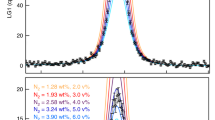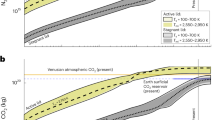Abstract
With temperatures around 700 K and pressures of around 75 bar, the deepest 12 km of the atmosphere of Venus are so hot and dense that the atmosphere behaves like a supercritical fluid. The Soviet VeGa-2 probe descended through the atmosphere in 1985 and obtained the only reliable temperature profile for the deep Venusian atmosphere thus far. In this temperature profile, the atmosphere appears to be highly unstable at altitudes below 7 km, contrary to expectations. We argue that the VeGa-2 temperature profile could be explained by a change in the atmospheric gas composition, and thus molecular mass, with depth. We propose that the deep atmosphere consists of a non-homogeneous layer in which the abundance of N2—the second most abundant constituent of the Venusian atmosphere after CO2—gradually decreases to near-zero at the surface. It is difficult to explain a decline in N2 towards the surface with known nitrogen sources and sinks for Venus. Instead we suggest, partly based on experiments on supercritical fluids, that density-driven separation of N2 from CO2 can occur under the high pressures of Venus’s deep atmosphere, possibly by molecular diffusion, or by natural density-driven convection. If so, the amount of nitrogen in the atmosphere of Venus is 15% lower than commonly assumed. We suggest that similar density-driven separation could occur in other massive planetary atmospheres.
This is a preview of subscription content, access via your institution
Access options
Access Nature and 54 other Nature Portfolio journals
Get Nature+, our best-value online-access subscription
$29.99 / 30 days
cancel any time
Subscribe to this journal
Receive 12 print issues and online access
$259.00 per year
only $21.58 per issue
Buy this article
- Purchase on Springer Link
- Instant access to full article PDF
Prices may be subject to local taxes which are calculated during checkout




Similar content being viewed by others
References
Crisp, D. & Titov, D. in Venus II, Geology, Geophysics, Atmosphere, and Solar Wind Environment (eds Bougher, S. W., Hunten, D. M. & Phillips, R. J.) 353–384 (Univ. Arizona Press, 1997).
von Zahn, U., Kumar, S., Niemann, H. & Prinn, R. in Venus (eds Hunten, D. M., Colin, L., Donahue, T. M. & Moroz, V. I.) 299–430 (Univ. Arizona Press, 1983).
Taylor, F. W., Crisp, D. & Bézard, B. in Venus II, Geology, Geophysics, Atmosphere, and Solar Wind Environment (eds Bougher, S. W., Hunten, D. M. & Phillips, R. J.) 325–351 (Univ. Arizona Press, 1997).
de Bergh, C. et al. The composition of the atmosphere of Venus below 100 km altitude: an overview. Planet. Space Sci. 54, 1389–1397 (2006).
Esposito, L. W., Knollenberg, R. G., Marov, M. I., Toon, O. B. & Turco, R. P. The Clouds and Hazes of Venus 484–564 (Univ. Arizona Press, 1983).
Oertel, D. et al. Infrared spectrometry of Venus from Venera-15 and Venera-16. Adv. Space Res. 5, 25–36 (1985).
Moroz, V. I., Linkin, V. M., Matsygorin, I. A., Spaenkuch, D. & Doehler, W. Venus spacecraft infrared radiance spectra and some aspects of their interpretation. Appl. Opt. 25, 1710–1719 (1986).
Yakovlev, O. I., Matyugov, S. S. & Gubenko, V. N. Venera-15 and -16 middle atmosphere profiles from radio occultations: polar and near-polar atmosphere of Venus. Icarus 94, 493–510 (1991).
Kliore, A. J. & Patel, I. R. Vertical structure of the atmosphere of Venus from Pioneer Venus orbiter radio occultations. J. Geophys. Res. 85, 7957–7962 (1980).
Taylor, F. W. et al. Structure and meteorology of the middle atmosphere of Venus: infrared remote sounding from the Pioneer Orbiter. J. Geophys. Res. 85, 7963–8006 (1980).
Hinson, D. P. & Jenkins, J. M. Magellan radio occultation measurements of atmospheric waves on Venus. Icarus 114, 310–327 (1995).
Drossart, P. et al. Scientific goals for the observation of Venus by VIRTIS on ESA/Venus Express mission. Planet. Space Sci. 55, 1653–1672 (2007).
Bertaux, J.-L. et al. SPICAV on Venus Express: three spectrometers to study the global structure and composition of the Venus atmosphere. Planet. Space Sci. 55, 1673–1700 (2007).
Tellmann, S., Pätzold, M., Hausler, B., Bird, M. K. & Tyler, G. L. Structure of the Venus neutral atmosphere as observed by the radio science experiment VeRa on Venus Express. J. Geophys. Res. 114, E00B36 (2009).
Keldysh, M. V. Venus exploration with the Venera 9 and Venera 10 spacecraft. Icarus 30, 605–625 (1977).
Seiff, A. et al. Measurements of thermal structure and thermal contrasts in the atmosphere of Venus and related dynamical observations—results from the four Pioneer Venus probes. J. Geophys. Res. 85, 7903–7933 (1980).
Linkin, V. M. et al. Vertical thermal structure in the Venus atmosphere from provisional Vega 2 temperature and pressure data. Sov. Astron. Lett. 12, 40–42 (1986).
Linkin, V. M., Blamont, J., Deviatkin, S. I., Ignatova, S. P. & Kerzhanovich, V. V. Thermal structure of the Venus atmosphere according to measurements with the Vega-2 lander. Kosm. Issled. 25, 659–672 (1987).
Bezard, B., de Bergh, C., Crisp, D. & Maillard, J.-P. The deep atmosphere of Venus revealed by high-resolution nightside spectra. Nature 345, 508–511 (1990).
Pollack, J. B. et al. Near-infrared light from Venus’ nightside—a spectroscopic analysis. Icarus 103, 1–42 (1993).
Meadows, V. S. & Crisp, D. Ground-based near-infrared observations of the Venus nightside: the thermal structure and water abundance near the surface. J. Geophys. Res. 101, 4595–4622 (1996).
Seiff, A., Schofield, J. T. & Kliore, A. J. et al. Model of the structure of the atmosphere of Venus from surface to 100 km altitude. Adv. Space Res. 5, 3–58 (1985).
Zasova, L. V., Ignatiev, N. I., Khatuntsev, I. A. & Linkin, V. Structure of the Venus atmosphere. Planet. Space Sci. 55, 1712–1728 (2007).
Hoffman, J. H., Oyama, V. I. & von Zahn, U. Measurement of the Venus lower atmosphere composition—a comparison of results. J. Geophys. Res. 85, 7871–7881 (1980).
von Zahn, U. & Moroz, V. Composition of the Venus atmosphere below 100 km altitude. Adv. Space Res. 5, 173–195 (1985).
Avduevskii, V. S. et al. Automatic stations Venera 9 and Venera 10—Functioning of descent vehicles and measurement of atmospheric parameters. Cosm. Res. 14, 655–666 (1977).
Zasova, L. V., Moroz, V. I., Linkin, V. M., Khatuntsev, I. V. & Maiorov, B. S. Structure of the Venusian atmosphere from surface up to 100 km. Cosm. Res. 44, 364–383 (2006).
Seiff A. & the VEGA Baloon Science Team, Further information on structure of the atmosphere of Venus derived from the VEGA Venus Balloon and Lander mission. Adv. Space Res. 7, 323–328 (1987).
Gierasch, P. J. et al. in Venus II, Geology, Geophysics, Atmosphere, and Solar Wind Environment (eds Bougher, S. W., Hunten, D. M. & Phillips, R. J.) 459–500 (Univ. Arizona Press, 1997).
Hendry, D. et al. Exploration of high pressure equilibrium separations of nitrogen and carbon dioxide. J. CO2 Util. 3–4, 37–43 (2013).
Spiga, A., Forget, F., Lewis, S. R. & Hinson, D. P. Structure and dynamics of the convective boundary layer on Mars as inferred from large-eddy simulations and remote-sensing measurements. Q. J. R. Meteorol. Soc. 136, 414–428 (2010).
Read, P. L. et al. Global energy budgets and ‘Trenberth diagrams’ for the climates of terrestrial and gas giant planets. Q. J. R. Meteorol. Soc. 142, 703–720 (2016).
Wordsworth, R. D. Atmospheric nitrogen evolution on Earth and Venus. Earth Planet. Sci. Lett. 447, 103–111 (2016).
Espanani, R., Miller, A., Busick, A., Hendry, D. & Jacoby, W. Separation of N2/CO2 mixture using a continuous high-pressure density-driven separator. J. CO2 Util. 14, 67–75 (2016).
Span, R. & Wagner, W. A new equation of state for carbon dioxide covering the fluid region from the triple-point temperature to 1100 K at pressures up to 800 MPa. J. Phys. Chem. Ref. Data 25, 1509–1596 (1996).
Landau, L. D. & Lifshitz, E. M. Fluid Mechanics Vol. 6 (Pergamon, 1959).
Lebonnois, S., Sugimoto, N. & Gilli, G. Wave analysis in the atmosphere of Venus below 100-km altitude, simulated by the LMD Venus GCM. Icarus 278, 38–51 (2016).
Lebonnois, S., Eymet, V., Lee, C. & Vatant d’Ollone, J. Analysis of the radiative budget of Venus atmosphere based on infrared Net Exchange Rate formalism. J. Geophys. Res. 120, 1186–1200 (2015).
Charnay, B. & Lebonnois, S. Two boundary layers in Titan’s lower troposphere inferred from a climate model. Nat. Geosci. 5, 106–109 (2012).
Lebonnois, S. et al. Superrotation of Venus’ atmosphere analysed with a full General Circulation Model. J. Geophys. Res. 115, E06006 (2010).
Poling, B., Prausnitz, J. & O’Connell, J. The Properties of Gases and Liquids (McGraw-Hill, 2001).
Ledoux, P. Stellar models with convection and with discontinuity of the mean molecular weight. Astrophys. J. 105, 305–321 (1947).
Hess, S. L. Static stability and thermal wind in an atmosphere of variable composition: applications to Mars. J. Geophys. Res. 84, 2969–2973 (1979).
Pierrehumbert, R. T. Principles of Planetary Climate (Cambridge Univ. Press, 2010).
Eymet, V. et al. Net-exchange parameterization of the thermal infrared radiative transfer in Venus’ atmosphere. J. Geophys. Res. 114, E11008 (2009).
Stefani, S., Piccioni, G., Snels, M., Grassi, D. & Adriani, A. Experimental CO2 absorption coefficients at high pressure and high temperature. J. Quant. Spectrosc. Radiat. Transfer 117, 21–28 (2013).
Haus, R., Kappel, D. & Arnold, G. Atmospheric thermal structure and cloud features in the southern hemisphere of Venus as retrieved from VIRTIS/VEX radiation measurements. Icarus 232, 232–248 (2014).
Haus, R., Kappel, D. & Arnold, G. Radiative heating and cooling in the middle and lower atmosphere of Venus and responses to atmospheric and spectroscopic parameter variations. Planet. Space Sci. 117, 262–294 (2015).
Crisp, D. Radiative forcing of the Venus mesosphere. I—Solar fluxes and heating rates. Icarus 67, 484–514 (1986).
Lee, C. & Richardson, M. I. A discrete ordinate, multiple scattering, radiative transfer model of the Venus atmosphere from 0.1 to 260 μm. J. Atmos. Sci. 68, 1323–1339 (2011).
Knollenberg, R. G. et al. The clouds of Venus: a synthesis report. J. Geophys. Res. 85, 8059–8081 (1980).
Acknowledgements
The authors thank L. Zasova for providing the VeGa-2 probe temperature profile, and J. Bellan for mentioning barodiffusion and useful discussion on this phenomenon. S.L. acknowledges the support of the Centre National d’Etudes Spatiales. G.S. acknowledges the support of the Keck Institute for Space Studies under the project ‘Techniques and technologies for investigating the interior structure of Venus’.
Author information
Authors and Affiliations
Contributions
Both authors contributed equally to the manuscript.
Corresponding author
Ethics declarations
Competing interests
The authors declare no competing financial interests.
Supplementary information
Supplementary Information
Supplementary Information (PDF 255 kb)
Rights and permissions
About this article
Cite this article
Lebonnois, S., Schubert, G. The deep atmosphere of Venus and the possible role of density-driven separation of CO2 and N2. Nature Geosci 10, 473–477 (2017). https://doi.org/10.1038/ngeo2971
Received:
Accepted:
Published:
Issue Date:
DOI: https://doi.org/10.1038/ngeo2971
This article is cited by
-
Possible Effects of Volcanic Eruptions on the Modern Atmosphere of Venus
Space Science Reviews (2024)
-
Supercritical fluids behave as complex networks
Nature Communications (2023)
-
Venus, the Planet: Introduction to the Evolution of Earth’s Sister Planet
Space Science Reviews (2023)
-
Mineralogy of the Venus Surface
Space Science Reviews (2023)
-
Venus Evolution Through Time: Key Science Questions, Selected Mission Concepts and Future Investigations
Space Science Reviews (2023)



